Top News
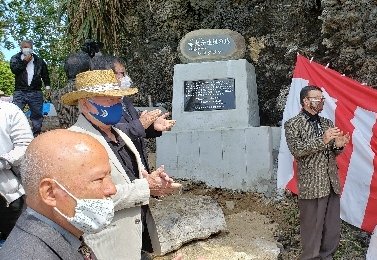
March 4, 2021 Ryukyu Shimpo
Tsuken Island, Uruma – A memorial and an explanatory sign were recently erected on Tsuken Island, the birthplace of Akainko, father of the sanshin. The memorial was prepared by the executive committee of a volunteer organization on the island that works to maintain Akainko’s birthplace. The unveiling ceremony was held on February 21, and participants celebrated by playing the sanshin. On Sanshin Day (Sanshin no Hi), March 4, there was a series of performances in front of the memorial.
Koichi Kamiya, representing the executive committee, said “Akainko’s achievements were great. Uta-sanshin is even known on the opposite side of the world. I hope that this memorial attracts many visitors.”
Akainko served the king during the reign of Sho Shin (1477-1526). His activities were varied, from poetry and music to architecture. He is also known as the father of the sanshin.
On Tsuken Island, there is a legend that a pregnant woman from Sobe, in Yomitan fled to Tsuken to protect herself. She had her child in Shinugu Gama Cave on the island. That child was Akainko.
The area around Shinugu Gama was in need of clean up after being hit by a typhoon that left boulders strewn about. Donations were collected from supporters of creating a memorial and the area was cleaned up. At the unveiling ceremony, six individuals and organizations were given certificates of appreciation.
(English translation by T&CT and Ellen Huntley)
Go to Japanese
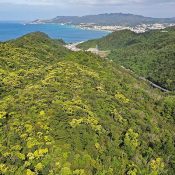
March 4, 2021 Ryukyu Shimpo
Buds and new green leaves in the trees in the northern part of Okinawa Island mark the arrival of spring.
On March 3 the weather in this region was overcast. However, in the surroundings of Yofuke, Nago City, warm rays of sunlight shone down brightly on Itaji chinkapin buds, providing a delightful sight to drivers who passed by. According to the Okinawa Meteorological Observatory, due to the influence of fronts and moist air in this region over the next week, there will be many cloudy days and rain is likely to fall in some places.
(English translation by T&CT and Erin Jones)
Go to Japanese
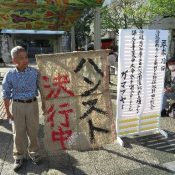
March 1, 2021 Ryukyu Shimpo
Takamatsu Gushiken, 67, who represents Gamafuya, a volunteer organization that collects the remains of those who died in the battle of Okinawa, began a hunger strike at the Prefectural Citizens Park in Izumizaki, Naha March 1. He is protesting against the Okinawa Defense Bureau (ODB), urging them to abandon their plan to collect dirt from the southern region of Okinawa’s main island for use in the Henoko new base construction land reclamation project. He is also demanding that Okinawa governor Denny Tamaki to order a stop to the quarrying project in Komesu, Itoman, where war-dead remains were found.
Gushiken told reporters, “Using earth that is mixed with the remains of those who died in war for constructing a new base is a mistake. It does not feel like the government has a sense of respect for the dead. I have decided on a hunger strike to protect the dignity of the victims of the Battle of Okinawa, and protect their remains. I want them to help the remains.”
The island’s southern region was the site of the bloody land battle that took place between the American and Japanese armies in the Battle of Okinawa 76 years ago, where soldiers and civilians alike lost their lives in large numbers. Many of the remains have yet to be recovered.
The ODB is planning on procuring about 32 million cubic meters of dirt, around 70% of the dirt they plan to procure from within Okinawa, from the towns of Itoman and Yaese in southern Okinawa to be used in land reclamation in Henoko Bay, part of the new base construction that is underway in Henoko.
Gushiken decided to carry out his hunger strike to inform people outside of the prefecture and the many people who have lost loved ones of this problem, and to foster a sense of solidarity. “The government have betrayed the thoughts of those who died in battle and their descendants. If people share the desire to protect the remains of the war-dead, they can skip as little one meal as a family, and show that we are all in this together.”
Itoman and Yaese is the location of the Okinawa Senseki Quasi-National Park, which is managed by Okinawa Prefecture, and development of the land is restricted under the Natural Parks Act. The excavators informed Okinawa Prefecture through Itoman City that they were beginning work in January. A man representing the company divulged to reporters of this newspaper that it was part of the land reclamation effort in Henoko. Gushiken expressed a sense of concern, stating, “It has become clear that the excavation in Komesu is proceeding in anticipation of the demand from Henoko. If the governor accepts the notification from the excavator, it will be highly likely that others will similarly come to develop the green belt in the south.
A number of religious leaders empathetic to Gushiken’s cause have also gathered, including retired catholic priest Daiji Tani, 68, who said, “Okinawa Senseki Quasi-National Park holds the memorials of many of those who died in the Battle of Okinawa, it is a holy place. I want the governor to protect this holy place, where the blood of the war dead has soaked the soil.”
Fumiko Shimabukuro, 91, a woman from Itoman who lived through the Battle of Okinawa and now resides in Henoko, also came to visit. Shimabukuro criticized the government’s plan, saying, “In the war, I drank water muddied with the blood of those who died in order to survive. Using the land mixed with the remains of those killed in the war for land reclamation is the same as killing them a second time. It certainly cannot be tolerated.”
Gushiken will carry out his hunger strike until March 6.
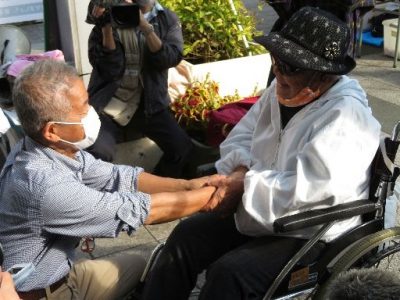
Henoko resident and Battle of Okinawa survivor Fumiko Shimabukuro visiting Gushiken and endorsing his protest
Go to Japanese
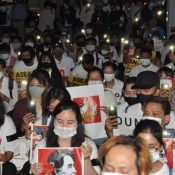
March 1, 2021 Ryukyu Shimpo
On February 28, the Association of Myanmarese in Okinawa held a memorial for those who died or were injured in protests against the military coup d’état in Myanmar. According to the association, around 300 people gathered at the Kenmin Hiroba plaza in Izumizaki, Naha for the memorial. The participants wrapped black tape around their left arms to pay their respects to the dead.
At the memorial, after participants engaged in a candle-lit prayer for one minute, there was an opportunity for people to speak about the current state of affairs in Myanmar. A statement was also presented that included a protest of the military coup.
A woman, age 29, living in Naha, who came to Okinawa from Myanmar in 2014 to study and now works in the service industry, said that her cousin and younger brother living in Myanmar were arrested for participating in the protests. “Those who express opposition there are in a continued state of fear from morning till night. I want to do what I can so that peace returns as soon as possible,” she said, tears filling her eyes as she spoke.
(English translation by T&CT and Sandi Aritza)
Go to Japanese
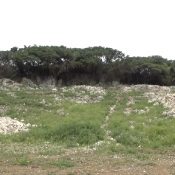
February 26, 2021 Ryukyu Shimpo
Okinawa prefecture and the Battle of Okinawa war-dead remains recovery information center started collecting remains at the planned dirt excavation site in Komesu, Itoman, where bones that appear to be from those who died in the Battle of Okinawa were found. According to the prefectural department of welfare and relief, collection of remains was in progress on February 24, focused on the slope behind the Tokyo Monument, and dozens of bone fragments measuring a few centimeters each have been found.
A representative from the welfare and relief department said, “We have not determined a clear plan and schedule for [collecting remains]. We will continue investigating while progressing onto the next location.” The rear slope of the Tokyo Monument is where Takamatsu Gushiken, a representative for the Battle of Okinawa war remains collection volunteer group “Gamafuya,” discovered bones last November.
The planned dirt excavation site also holds the location of the Okinawa Senseki Quasi-National Park. In January, the excavators notified Okinawa prefecture that they would begin development, as dictated by Japan’s Natural Parks Act. The Okinawa Defense Bureau (ODB) is procuring dirt the southern region of Okinawa’s main island including towns such as Itoman and Yaese, for use in land reclamation for the new base construction in Henoko.
Gushiken is concerned that there may be bones mixed in with the sediment, and has demanded that the ODB call off their plan. After receiving the development notification, the governor has 30 days to order a ban, and since the area is a designated natural park, Gushiken is also requesting the governor enact these measures.
(English translation by T&CT and Sam Grieb)
Go to Japanese
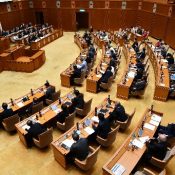
February 24, 2021 Ryukyu Shimpo
A member of the U.S. Marine Corps stationed at Camp Courtney was arrested on February 11 on suspicion of indecent assault. On February 24, in a plenary session, the Okinawa Prefectural Assembly unanimously passed a protest resolution and written opinion calling for the U.S. government, Japanese government, and U.S. military to issue apologies and reparations to the victim of the indecent assault, and calling for thorough countermeasures to such occurrences. The protest resolution and written opinion severely criticized the incident with the words “This is a crime that violates human dignity.” The members of the Special Committee on U.S. Base Affairs then visited and delivered the protest resolution and written opinion to concerned agencies such as the Okinawa Defense Bureau and Consulate-General of the U.S. in Okinawa.
Taking into account the seemingly endless stream of incidents/accidents by U.S. military personnel, the protest resolution and written opinion contain the assertion that “It must be said that human rights education efforts and military personnel management systems are not functioning.” Additionally, the resolution and opinion called for (1) apologies and complete reparations for victims and families of victims, (2) enforcement of official discipline and an effective recurrence prevention policy, (3) observance of guidelines concerning actions outside of working hours (the Liberty Policy), (4) holding early-stage meetings of the Cooperative Working Team (CWT) for preventing incidents/accidents by U.S. military personnel and civilians in military employ, and (5) a drastic revision of the U.S.-Japan Status of Forces Agreement.
Recipients of the protest resolution include the U.S. ambassador to Japan and the commander of the U.S. Forces, Japan, and recipients of the written opinion include the prime minister, the foreign minister, and the defense minister.
(English translation by T&CT and Erin Jones)
Go to Japanese
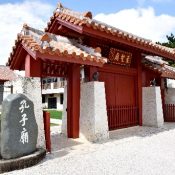
February 24, 2021 Ryukyu Shimpo
On February 24, the Supreme Court ruled on the question of whether Naha City’s free provision of land in Matsuyama Park for the Kume Shiseibyo (Koshibyo), which is dedicated to Confucius, father of Confucianism, violates the principle of the separation of politics and religion in the constitution. The court, with Naoto Otani presiding, ruled that the free provision is unconstitutional.
The separation of politics and religion requires that national and municipal governments remain neutral in religious matters. After the case was remanded, the first and second rulings both held that Koshibyo is a religious facility, and thus the free provision of land by Naha City is unconstitutional.
The plaintiff asserted that the Sekitensairei, an event held at Koshibyo, has religious significance, and that the free provision of land violates the principle of the separation of politics and religion, saying, “Koshibyo is a religious facility, from both an academic perspective and in the eyes of the general population. This amounts to the assistance and promotion of a specific religion.”
Meanwhile, representatives of Naha City argued that Koshibyo is “an educational facility that tells Okinawa’s history and culture, and has no religious meaning.” The facility is an important tourist attraction, and “the waiving of usage fees is done for the public good. It is not assistance or promotion of a religion.”
(English translation by T&CT and Ellen Huntley)
Go to Japanese

February 26, 2021 Ryukyu Shimpo
On February 23, the city council of Berkeley, California, passed a resolution in solidarity with the people of Okinawa, opposing the construction of a new base in Henoko, Nago City–the planned relocation site for U.S. Marine Corps Futenma Air Station. The official motion demands the immediate and complete halt of the Henoko base construction.
In September 2015, the Berkeley City Council became the first American local council to pass a resolution opposing the relocation of Futenma Air Station to Henoko. In December 2017, the council passed another resolution opposing the construction of U.S. military helipads in Takae, Higashi Village, and the subsequent training exercises.
The latest resolution offers background on Henoko and Oura Bay and explains that the prospective site is one of the world’s richest areas of biodiversity. The council noted that Japanese and American environmental groups previously brought a suit in the U.S. to halt the base construction, citing its effects on the endangered dugong habitat.
The motion also states that the soft seabed at the site has caused the construction time and costs to balloon, delaying Futenma Air Station’s closure. The council also noted the result of the prefectural referendum held in February 2019, in which more than 70% of voters voted “no” to reclaiming land at Henoko. Although the referendum established the will of the Okinawan people, the Japanese government, with support from the U.S., continues to reclaim land from the beautiful sea.
The resolution will be delivered to the U.S. House Armed Services Committee as well as Representative Barbara Lee and Senator Dianne Feinstein, both of California.
(English translation by T&CT and Monica Shingaki)
Go to Japanese
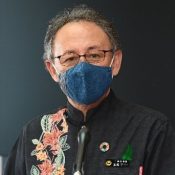
February 22, 2021 Ryukyu Shimpo
On February 21, Governor Denny Tamaki visited the planned mining site in Komesu, Itoman within the Okinawa Senseki (battle site) Quasi-National Park. Governor Tamaki himself told the Ryukyu Shimpo of this visit.
According to Governor Tamaki, on the morning of February 21, he visited the site with staff from relevant departments. The mining company submitted a notice of development in Itoman pursuant to the Natural Parks Act last year.
The municipal government of Itoman City sent the notice to the prefectural government together with a letter of opinion, and the prefectural government is presently reviewing the notice to decide whether to accept it.
In light of the design changes for the new base construction in Henoko, Nago as part of the relocation of U.S. Marine Corps Air Station Futenma, the Okinawa Defense Bureau expanded the soil mining sites to include one in the southern part of Okinawa Island, where the remains of people who died in the Battle of Okinawa are still located. This plan has drawn criticism from those involved in collection of such remains.
(English translation by T&CT and Sandi Aritza)
Go to Japanese
February 21, 2021 Ryukyu Shimpo
Okinawa governor Denny Tamaki sent a written appeal to cabinet ministers such as Minister for Foreign Affairs Toshimitsu Motegi, asking that the Japanese government secure the Senkaku Islands and surrounding areas, and improve their relationship with China.
In addition to this, the written request also asks that Japan clearly indicate to the international community that the Senkaku Islands are an intrinsic territory of Japan. The letter was addressed to four cabinet members including Foreign Minister Motegi, Minister of Land, Infrastructure, Transport and Tourism Minister Kazuyoshi Akaba, Minister of Defense Nobuo Kishi, and Minister of State for Okinawa and Northern Territories Affairs Taro Kono.
On February 15 and 16, Chinese Coast Guard boats were seen approaching Japanese fishing vessels in the water near the Senkaku islands.
(English translation by T&CT and Sam Grieb)
Go to Japanese
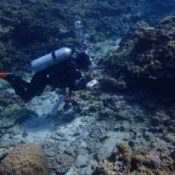
February 18, 2021 Ryukyu Shimpo
On February 17, the Okinawa Defense Bureau (ODB) opened the 30th meeting of the Environmental Monitoring Committee (chaired by Yoshiyuki Nakamura, Professor at Yokohama National University Graduate School) at the Okinawa Defense Bureau in Kadena Town in regards to relocating USMC Futenma Air Station to Henoko, Nago City. The ODB officially announced that five of the nine colonies of Porites okinawensis Veron, that were transplanted in 2018 from the ocean area where land reclamation is taking place, were confirmed to have died. It appears these colonies were dead by October 20 last year. The ODB maintains that the death of the colonies was not due to transplantation.
Concerning the transplantation of the Porites okinawensis Veron, the Ministry of Defense (MOD) confirmed that a portion of the coral has spawned, and thus maintains that the “transplantation is succeeding”. However, environmental groups and the Okinawa prefectural government doubt the validity of these claims.
At the Committee meeting on this day, head officers of the ODB mentioned the results of monitoring the transplanted Porites okinawensis Veron as well as those which were originally living at the transplantation destination, and confirmed that the colonies that died did not die due to transplantation. In the monitoring of Porites okinawensis Veron that were originally living at this location, five out of twelve colonies were confirmed to have died.
According to Chairman Nakamura, who held a press conference after the Committee meeting, none of the committee members identified the coral dying as an effect of construction work. However, the committee members were of the opinion that the number of coral colonies to be monitored should be increased in order to investigate the annual survival rate of the coral.
(English translation by T&CT and Erin Jones)
Go to Japanese











 Webcam(Kokusai Street)
Webcam(Kokusai Street)


